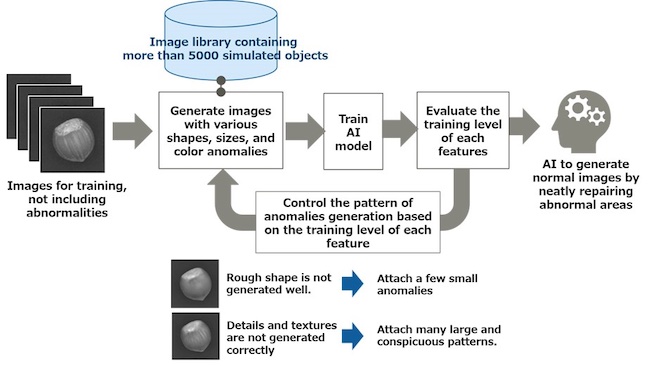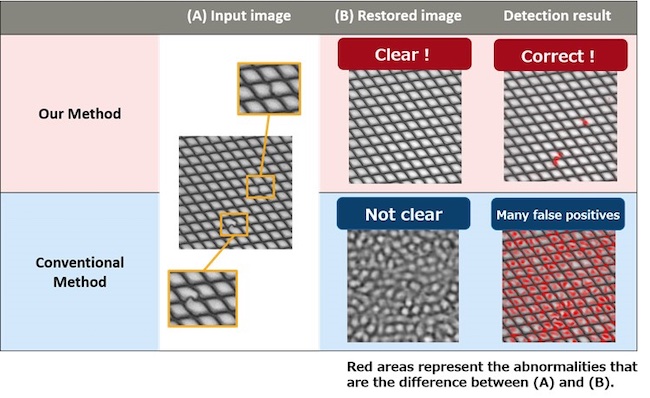Fujitsu Develops AI for Image Inspection to Detect Abnormalities in Product Appearance with World-Leading Precision in Key Benchmark
- Written by ACN Newswire - Press Releases

|
|
| Fig 1. Outline of the development technology |
|
|
| Fig 2. Comparison with the prior art |
This technology is capable of correctly detecting abnormalities like frayed threads and defective wiring patterns in products that vary individually, even if they appear normal, such as carpets with different wool or color, or printed circuit boards with different wiring shapes depending on the part. The developed technology successfully achieved world leading accuracy (1) in a benchmark using public data (2) collected from external images of various manufactured goods.
Fujitsu verified the effectiveness of this technology during the inspection process at the Nagano Plant of Fujitsu Interconnect Technologies Limited, a factory that manufactures electronic equipment, and confirmed its effectiveness in reducing man-hours required for inspecting printed circuit boards by 25%. The technology ultimately offers the potential to help reduce the workload of workers at manufacturing plants and improve productivity, while helping to introduce new working styles for frontline staff.
Background & Challenges
At the site of the inspection process, the inspector determines whether the product is defective based on features such as its approximate shape, detailed structure, and texture. For example, approximate shape is considered important in a shape distortion test, and texture is considered important in a condition or pattern test. Furthermore, even if the product appears normal, if there are individual variations in elements like coating, color, and wiring shape, these characteristics are examined for each item, and the inspection is conducted while distinguishing whether individual differences or abnormalities fall within the acceptable range. Therefore, when training AI to conduct quality control tasks, it is necessary to be able to capture a wide variety of features that occur on an individual basis in a normal image. However, the typical method of training an AI model using weighted and summed indices for each characteristic has led to a tendency to focus on only one characteristic, and it has proven difficult to create a model that fully grasps all the characteristics.
About the Newly Developed Technology
With this technology, the AI restores the normal image from which the abnormality has been removed when an abnormality is detected, and detects the abnormal part by capturing the difference between the image to be inspected and the restored normal image. Fujitsu has developed a method to train an AI model so that a normal image without a variety of anomalies such as shape, size, and color can be restored by artificially adding the simulated abnormalities to a normal image prepared for training. The improved ability to restore normal images has made it possible to detect abnormal areas with high accuracy without preparing images containing abnormalities as training data. During training, Fujitsu compares the normal image with the image restored by AI, evaluates the degree of training of each feature such as approximate shape, detailed structure, and texture, and control the size, color, and number of abnormalities to be added so that AI preferentially learns features not captured. For example, if the AI is not able to correctly restore the approximate shape, it trains with abnormal images with a few small abnormalities that do not affect the normal appearance. Also, if the details and texture are slightly different, the AI trains with many abnormal images that are large enough to obscure the details or add a conspicuous pattern. In this way, by evaluating the state of AI restoration and training on weak areas where AI cannot restore features, it became possible to restore normal images that captured all features.
In addition, Fujitsu has developed a new technology that generates materials of various shapes, sizes, and colors from a library of images of more than 5000 kinds of artificial objects, and adds abnormalities by probabilistically changing the number of abnormalities and the position to which they are added.
Outcomes
The developed technology achieved world leading accuracy, with an AUROC (3) score exceeding 98% in a class of products that have variations in their normal appearance, such as carpets with different fur patterns and colors on an individual basis and printed circuit boards with different wiring shapes on different parts. In addition, there is no variation in individual products such as screws and nuts, and in products where non-defective products have a uniform appearance, accuracy equivalent to that of conventional technologies (4) was also successfully maintained.
The real-world effectiveness of this technology was verified during the inspection process at the Nagano Plant of Fujitsu Interconnect Technologies, a manufacturer of electronic equipment. The technology succeeded in reducing man-hours required for inspecting printed circuit boards by 25%.
Future Plans
In the future, Fujitsu will further develop this and other related technologies to support Fujitsu's portfolio of AI technologies, "FUJITSU Human Centric AI Zinrai," and aims to apply this new approach to Fujitsu's manufacturing brand "COLMINA," which delivers digital transformation (DX) for the manufacturing industry.(1) world leading accuracy:The accuracy was achieved for AUROC in comparison with the technologies listed in the benchmark ranking of anomaly detection technology using MVTec AD in the target class with variations in normal appearance. Company data as of March 29, 2021.(2) benchmark using public data:MVTec Anomaly Detection Dataset offered by MVTec.(3) AUROC:Area Under the ROC Curve. A measure of the performance of a model that detects abnormalities. With a maximum score of 100%, the higher the score on the index, the better the model's performance.(4) conventional technology:Technology listed in the benchmark ranking of anomaly detection technology using MVTec AD
About Fujitsu
Fujitsu is the leading Japanese information and communication technology (ICT) company offering a full range of technology products, solutions and services. Approximately 130,000 Fujitsu people support customers in more than 100 countries. We use our experience and the power of ICT to shape the future of society with our customers. Fujitsu Limited (TSE:6702) reported consolidated revenues of 3.9 trillion yen (US$35 billion) for the fiscal year ended March 31, 2020. For more information, please see www.fujitsu.com.About Fujitsu Laboratories
Founded in 1968 as a wholly owned subsidiary of Fujitsu Limited, Fujitsu Laboratories Ltd. is one of the premier research centers in the world. With a global network of laboratories in Japan, China, the United States and Europe, the organization conducts a wide range of basic and applied research in the areas of Next-generation Services, Computer Servers, Networks, Electronic Devices and Advanced Materials. For more information, please see: http://www.fujitsu.com/jp/group/labs/en/.
Copyright 2021 JCN Newswire. All rights reserved. www.jcnnewswire.com
Authors: ACN Newswire - Press Releases
Read more //?#



